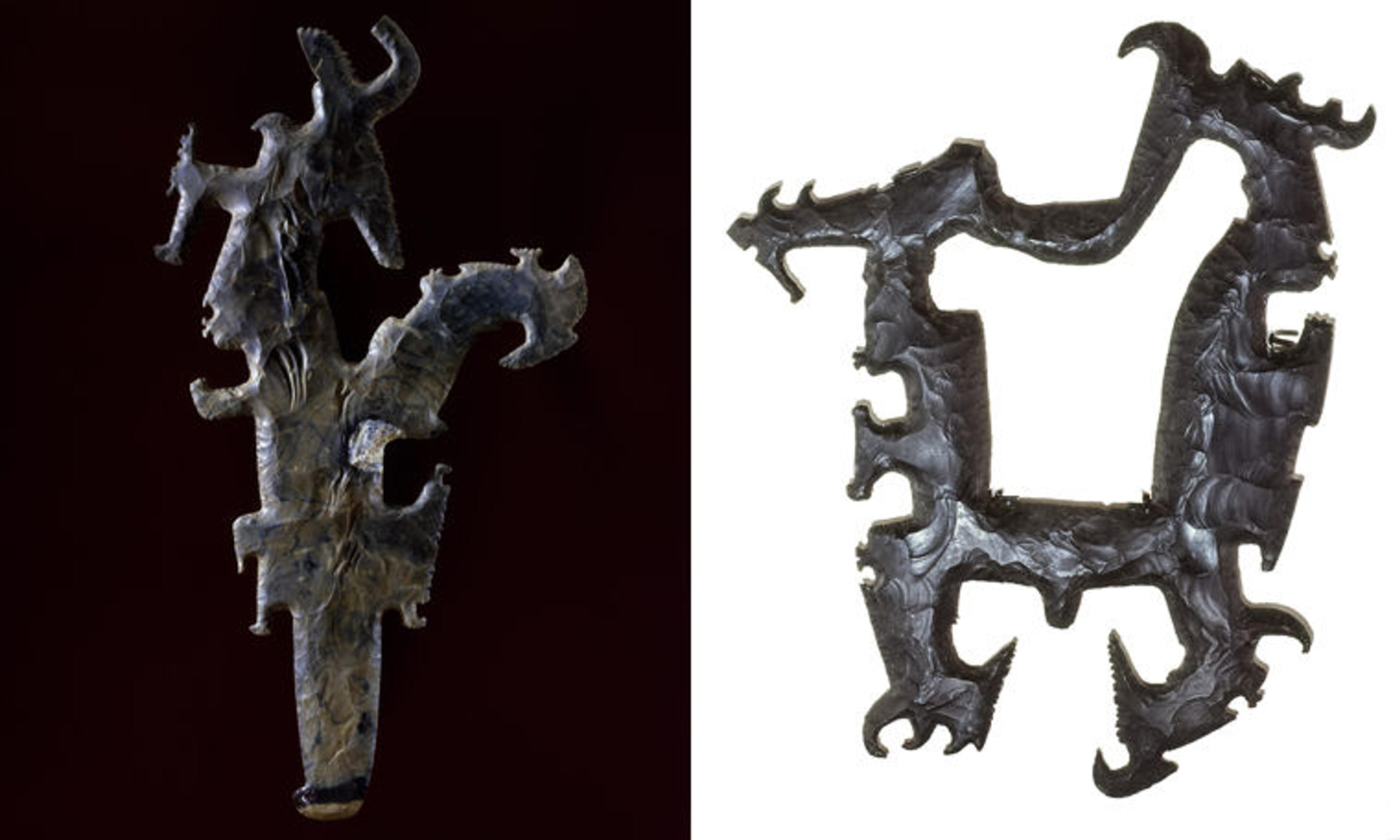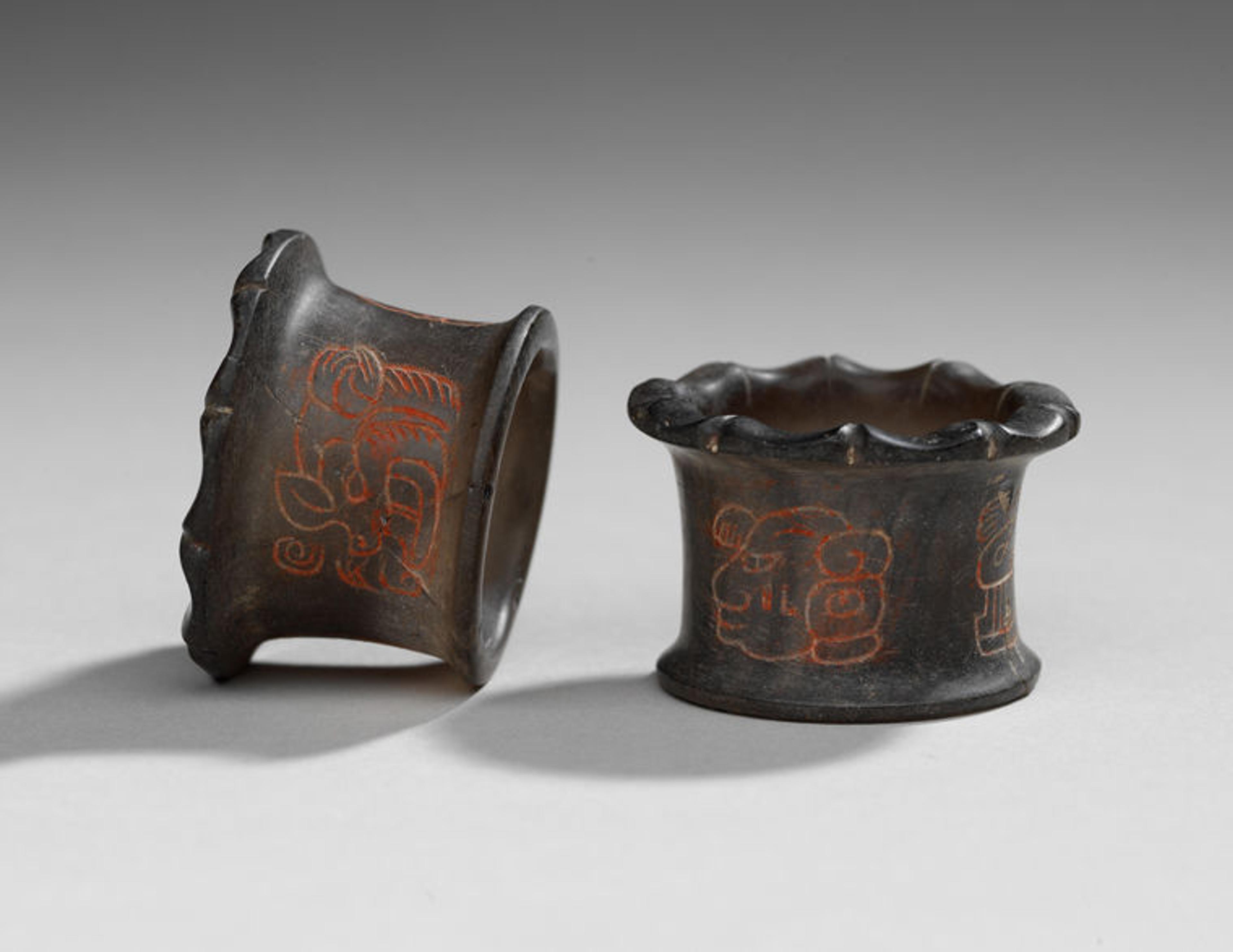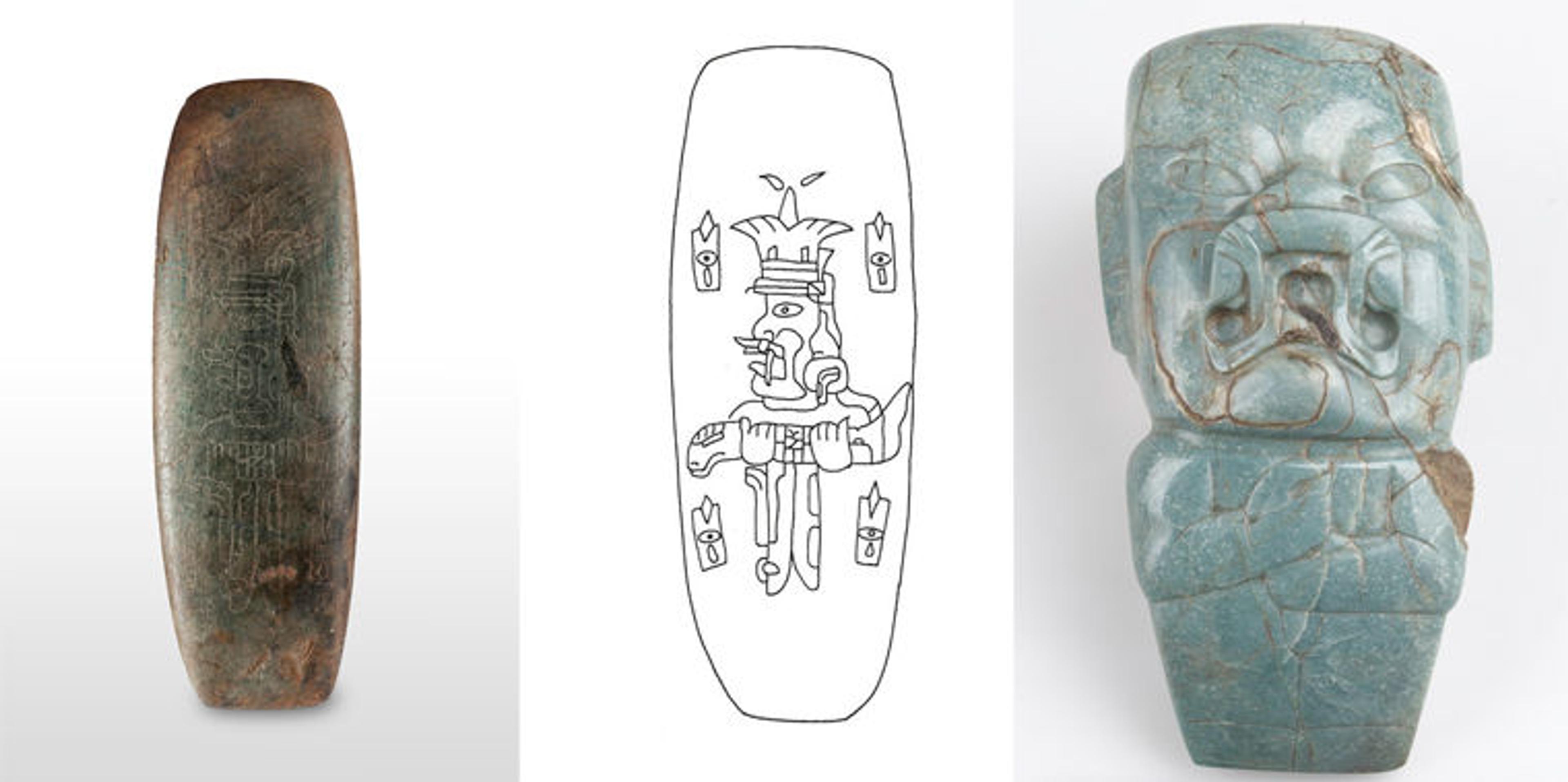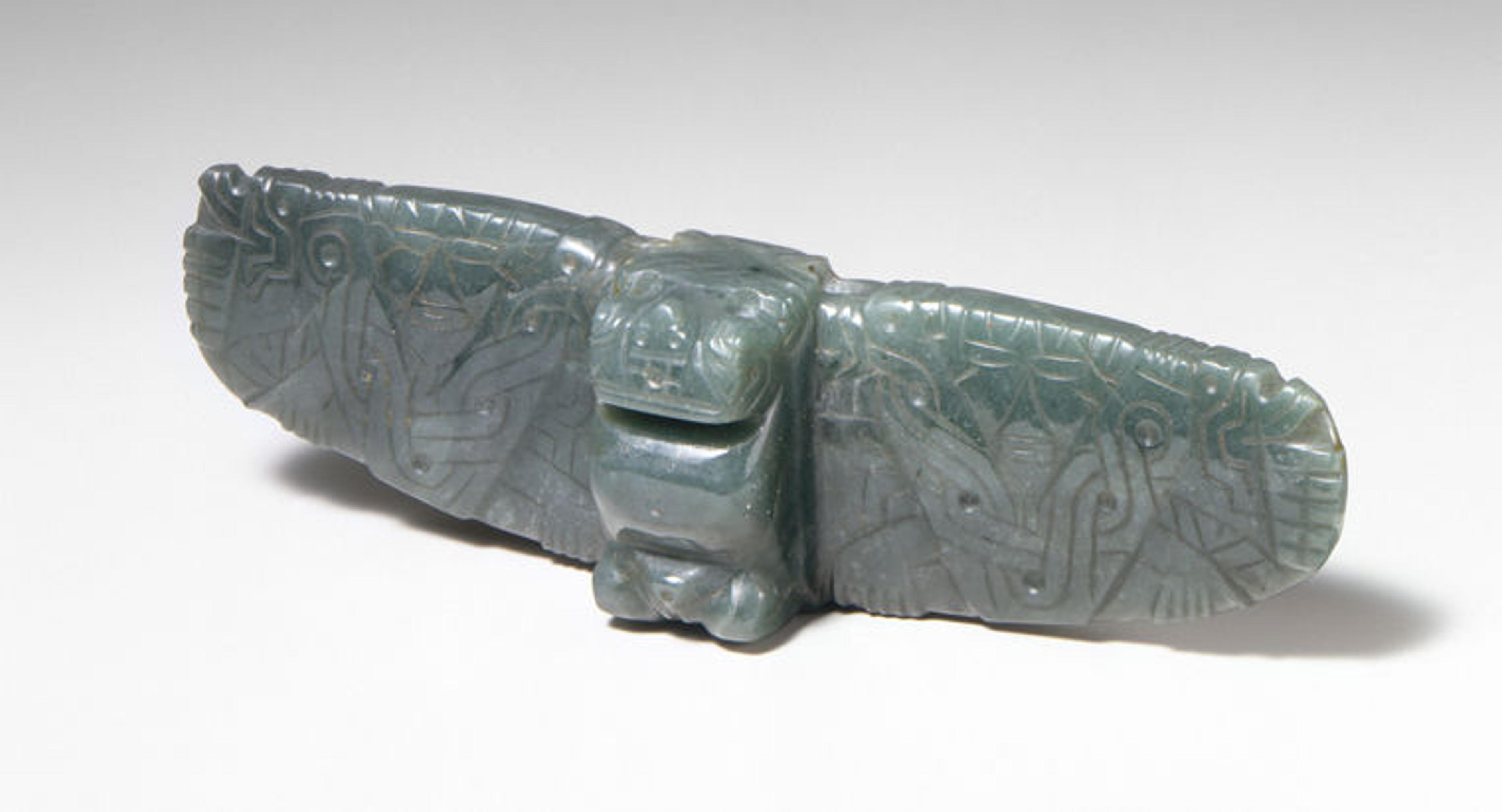«Stone blades of various types and sizes were produced in the Americas as early as people arrived, including projectile points, hand axes, scrapers, chisels, and other tools. Whether uniface (one sharp edge) or biface (two sharp edges), stone blades with beveled edges had the obvious primary function of cutting. By the second millennium B.C., however, ceremonial blades and bodily regalia made from blades became the media of choice for sculptors in the Americas, who created works of art that transcended the utilitarian or functional. For more than three millennia, indigenous artists in the Western Hemisphere created blades that have been noted for their beauty by both ancient and modern beholders. A global look at ancient blades finds analogous cases, such as in ancient Egypt or China, where weapons were inscribed or ceremonial blades were fashioned from precious nephrites.»

Above: Fig. 1. Ceremonial knife (tumi), A.D. 900–1100. Peru, North Coast. Lambayeque. Gold, silver, turquoise, H: 36.2 cm (14 1/4 in.). The Metropolitan Museum of Art, New York, Gift and Bequest of Alice K. Bache, 1974, 1977 (1974.271.60)
An astonishing array of blades from Peru to Mexico is on view through May 28 in the exhibition Golden Kingdoms: Luxury and Legacy in the Ancient Americas. The earliest examples, known as celts, are petaloid stone blades (which are shaped like a flower's petals) destined for sacred offerings. Later metal and flint blades of various forms were vital ceremonial objects used in ritual performance. In Mesoamerica, blades made of greenstone, including jadeite, were powerful symbols of power over maize agriculture, a key component of rulers' claims to political power. In the Central Andes, on the other hand, crescent-shaped blades, known as tumis, were intimately associated with themes of sacrifice that endured from the late first millennium B.C. until the arrival of Europeans in the sixteenth century (fig. 1).
In Mesoamerica, centuries of co-opting agricultural power necessitated that symbolic blades form part of the ritual toolkits for societies such as the Olmec, the Maya, and the Aztec. Early agriculturalists used chert and flint, which appear as nodules in the limestone geology of the Yucatán Peninsula. The crystalline quartz structure of sedimentary cherts allows them to be flaked into various sharp tools using percussion techniques. Lacking metal tools, the Classic Maya (ca. A.D. 250–900) probably cleared tropical forests with chert blades. The power of flint blades was also associated with lightning; the fractures of chert during percussion were likened to the unpredictable splitting of lightning in the sky (fig. 2). The chopping of chert blades against wood was equivalent to divine chops of thunder in the sky.

Fig. 2. Left: Scepter with profile figures, A.D. 600–800. Guatemala. Maya. Flint, 34.6 x 19.1 x 1.6 cm (13 5/8 x 7 1/2 x 5/8 in.). The Metropolitan Museum of Art, New York, The Michael C. Rockefeller Memorial Collection, Purchase, Nelson A. Rockefeller Gift, 1967 (1978.412.195). Right: Scepter with profile figures, A.D. 711. Mexico, Campeche, El Palmar. Maya. Flint, 31.7 x 26 x 1.3 cm (12 1/2 x 10 1/4 x 1/2 in.). Mexico City, Museo Nacional de Antropología (10-9648), Secretaría de Cultura—INAH
Flintknappers channeled the fractal unpredictability of lightning into masterful scepters in the seventh and eighth centuries. Lightning made manifest in the ground as chert was transformed into profile images of the gods of lightning, which presumably would have been hafted to a wooden staff. Dozens of images of Maya kings and queens exist on stone monuments in which they grasp the foot of K'awiil, the lightning god. The dark brown flint from the site of El Palmar, Campeche, is an exceptional example of one of these flints, known as "eccentrics" for their unique and impractical shapes (fig. 2).
In addition to local chert blades, residents of Maya Lowland sites used obsidian, an igneous volcanic glass, for detailed cutting. This included daily activities such as cooking and weaving, but also ritual activities. Though found primarily in the Guatemalan Highlands, the trade of cores extracted from veins was widespread. Many households, not just elite palaces structures, had access to the blades. Cores, the prismatic raw chunks from which blades were percussed, were sometimes offered in dedicatory caches, perhaps transferring the potential energy of the yet-to-be blades to the space in which it consecrated.

Fig. 3. Pair of earspools, A.D. 400–500. Belize, Altun Ha, Tomb A-1/1. Maya. Obsidian, cinnabar, H: 2.9 cm (1 1/8 in.), Diam.: 4.4 cm (1 3/4 in.). Belmopan, Belize, Institute of Archaeology, Courtesy of the Royal Ontario Museum, Toronto (L965.9.78.A, L965.9.78.B)
The creativity of Maya obsidian artists shows through in the spectacular pair of earspools excavated at the coastal site of Altun Ha, in modern-day Belize (fig. 3). The sculptor softened the sharpness of the prismatic blades, evoking blooming flowers with the scalloped outer rim. (Floral imagery is a widespread feature of earflare assemblages.) The examples in Golden Kingdoms were originally made for a royal woman, as specified by the delicately incised hieroglyphic text, fill-painted in red, that encircles the earspools' cylindrical forms. Valued possessions—one of the earspools was broken and carefully repaired in antiquity—these were passed down through generations, and later recovered form a rich tomb of a male.
The most valued material for Mesoamerican blades, however, was jadeite. Mined from sources in the Motagua River Valley in Guatemala, jadeite was a principal medium of sculpture for the Olmec and Maya rulers who commissioned ceremonial blades and blade-shaped pendants. For the Olmec, especially at the large center of La Venta, Tabasco, jadeite and other greenstone blades symbolized solid and permanent maize sprouts. Maize, the staple crop of early Mesoamericans, was very important to sustaining societies, and the cycles of agriculture held specific importance for patrons and their artists. On some celts, people inscribed images of the Olmec maize god, often associated with clefts sprouting young shoots of corn (figs. 4a–b). Blades for the Olmec came alive as snarling mythological beings. A tour-de-force example is the hefty blue-green jade "Kunz Axe," where the feet of the deity form the sharp blade (fig. 4c).

Fig. 4a (left). Celt with Olmec maize god, 900–400 B.C. Mexico, Veracruz, Arroyo Pesquero. Olmec. Jadeite, 27.1 x 8.9 x 4.4 cm (10 11/16 x 3 1/2 x 1 3/4 in.). Xalapa, Museo de Antropología de Xalapa, Universidad Veracruzana (Reg. 49 P.J. 4011). Fig. 4b (center). Drawing of fig. 4a, attributed to Linda Schele or F. Kent Reilly. Fig. 4c (right). Ceremonial ax ("Kunz Ax"), 1000–400 B.C. Mexico, Oaxaca. Olmec. Jadeite, 31 x 16 x 11 cm (12 3/16 x 6 5/16 x 4 5/16 in.). American Museum of Natural History, New York (30/7552)
Petaloid celts, valued whole by the Olmecs, were split up and worn by early Maya rulers. Maize symbolism was also prevalent in Maya art beginning in the Late Preclassic period (ca. 300 B.C.–A.D. 250). The maize god, through veneration and impersonation, was an integral character in the epic myths that underpinned the institution of divine Maya kingship. The split-celt belt ornaments, like the set from Calakmul or the example from the collection of the Kimbell Art Museum (right), added a dimension of blue-green color, textuality through inscriptions, and sonorous output as they clanked together (fig. 5). The Kimbell's celt shows exactly how these sets would be worn, suspended from a larger jade sculpture, similar to the one recovered from the cenote of Chichen Itza, originally from Piedras Negras.

Right: Fig. 5. Royal belt ornament, A.D. 400–500. Guatemala. Maya. Jadeite, 23.5 x 7.6 x 0.3 cm (9 1/4 x 3 x 1/8 in.). Fort Worth, Kimbell Art Museum (AP 2004.05)
Jade blades from Mesoamerica traveled far and wide as valuable exchange objects, especially by the societies in what is now Costa Rica. (A particularly compelling example of the transcultural value of jades is an Olmec "spoon" recovered far south of the Maya area in Costa Rica, which had been re-used and incised with an inscription by an early Maya king.) A large jadeite clamshell, originally created in Mexico, was deposited in a tomb at the site of Talamanca de Tibás, along with a distinctively Costa Rican avian celtiform pendant (fig. 6a).

Fig. 6a (left). Bird-celt pendant, 900–400 B.C. (initial fabrication); A.D. 300–500 (deposition). Central Region; Costa Rica, San José Province, Talamanca de Tibás, Principal Tomb. Jadeite, 20.3 x 5.9 cm (8 x 2 5/16 in.). San José, Museo Nacional de Costa Rica (1.5 TR 2C[34]). Fig. 6b (center). Figure-celt pendant, A.D. 100–500. Central Region; Costa Rica. Jadeite, 9.6 x 3.8 cm (3 3/4 x 1 1/2 in.). San José, Museo del Jade (6643 INS). Fig. 6c (right). Bird-celt pendant, A.D. 300–800. Guanacaste-Nicoya; Costa Rica. Jadeite, 12 x 2.5 cm (4 3/4 x 1 in.). San José, Museo Nacional de Costa Rica, 7745
This large abstracted image of a bird is a prime example of a category of blade-like pendants made by ancient artists in Costa Rica, known as "axe gods," which also include anthropomorphic imagery (fig. 6b). The sculptors obtained jadeite axe blades that had been created by Olmec or other peoples in Mesoamerica and remade them in their own distinctive styles. Jadeite was such a rare and valued material in Costa Rica, where geologists have found no local sources of the mineral. Some artists thinned pendants, such as one in the form of a crested, long-tailed bird (possibly a resplendent quetzal, Pharomachrus mocinno), created from just one sixth of the original full axe (fig. 6c).

Fig. 7. Bat-winged pendant, A.D. 300–500. Guanacaste-Nicoya; Costa Rica, Las Huacas, Burial VIII. Jadeite, 4.1 x 15.3 x 2.9 cm (1 5/8 x 6 x 1 1/8 in.). Pittsburgh, Carnegie Museum of Natural History (2939/1181)
Jades and other greenstone axes in ancient Costa Rica, Panama, and Colombia were also transformed into horizontally strung "winged pendants" (for non-blade examples, see the exceptional abstract pendants in tawny agate from Sitio Conte, Panama, or a sublime gold Malagana example from Colombia). Except for a very slight asymmetry in the wings of this masterful pendant excavated at Las Huacas, Costa Rica (fig. 7), there are few traces that suggest the prior life of the bat-winged work was a large jadeite blade. The inclusion of incised triangular heads, apparently human, between the wingtip and the body of the figure suggests that jadeite still retained its association with cutting or chopping, even for peoples in faraway Costa Rica. The closed eyes indicate that these could be trophy heads, which would presumably been disembodied with a sharp, stone blade.
Resources
Agurcia Fasquelle, Ricardo, Payson Sheets, and Karl Andreas Taube. Protecting Sacred Space: Rosalila's Eccentric Chert Cache at Copan and Eccentrics among the Classic Maya. San Francisco: Precolumbia Mesoweb Press, 2016.
Berrin, Kathleen, and Virginia M. Fields, eds. Olmec: Colossal Masterworks of Ancient Mexico. New Haven: Yale University Press, 2010.
Jones, Julie, ed. Jade in Ancient Costa Rica. New York: The Metropolitan Museum of Art, 1998.
Pillsbury, Joanne, Miriam Doutriaux, Reiko Ishihara-Brito, and Alexandre Tokovinine, eds. Ancient Maya Art at Dumbarton Oaks. Washington, D.C.: Dumbarton Oaks, 2012.
Pillsbury, Joanne, Timothy Potts, and Kim N. Richter, eds. Golden Kingdoms: Luxury Arts in the Ancient Americas. Los Angeles: The J. Paul Getty Museum, 2017.
Related Content
Golden Kingdoms: Luxury and Legacy in the Ancient Americas, on view at The Met Fifth Avenue through May 28, 2018
See more digital content related to Golden Kingdoms, including a walkthrough of the recent exhibition in English and in Spanish.
Read more articles in this exhibition's blog series.
Purchase a copy of the exhibition catalogue in The Met Store.
